IDF 2009 - Intel Shows off 22nm & 32nm, Sandy Bridge Demoed
by Anand Lal Shimpi on September 22, 2009 12:00 AM EST- Posted in
- Trade Shows
This is a big IDF, it's my first without Pat Gelsinger at Intel. We're unlikely to hear much about Pat's departure here, but the rumor mill appears active with everything from him being kicked out due to Larrabee's initial issues (unlikely) to him not being selected to be the next in line for CEO succession at Intel (much more likely).
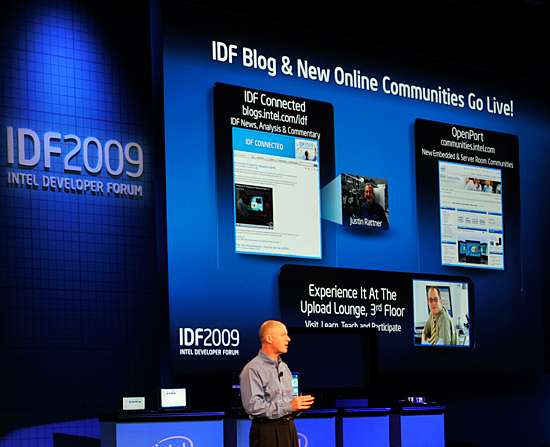
Sean Maloney, the heir to Otellini's throne at Intel - not Gelsinger
Regardless of what the motivations were, he will be sorely missed. Pat Gelsinger was the first person I met in this industry who truly blew me away with his knowledge. He has a rare combination of pure genius, passion and an incredible ability to convey even the most complicated concepts in a very easy to understand manner. He's been a tremendous influence on my own style of writing and knowledge, and for that I'll be forever grateful. Pat, you will be missed.
1B+ Transistors at 32nm, Working 22nm SRAM
Otellini gave us a status update on Moore's Law. 32nm is healthy and we'll see the first products based on Westmere later this year:
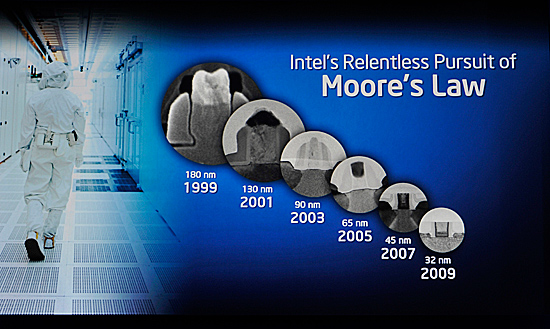
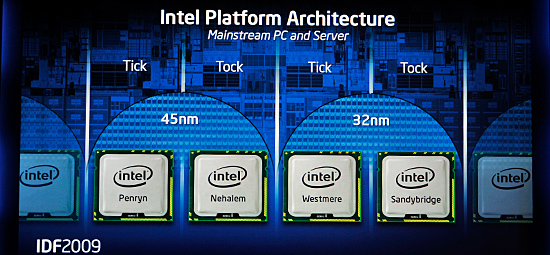
The move to 32nm will allow Intel to ship microprocessors with over 1 billion transistors into the consumer space. Sweet.
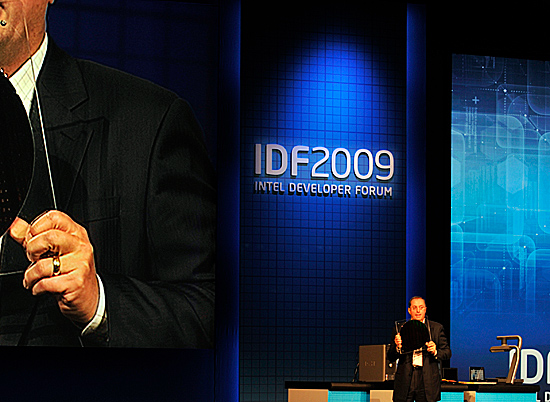
The first 22nm test wafer, fully functional
We also got the first look at Intel's 22nm SRAM test vehicle. The relevant details are as follows: 2.9 billion transistors per SRAM chip, each arey is 364Mb and production in CPUs in the second half of 2011.
Atom Gets Tick Tock, Sorta
Paul outlined the roadmap for the Atom processor and you'll notice that its progression looks a lot more like how Intel used to do things:
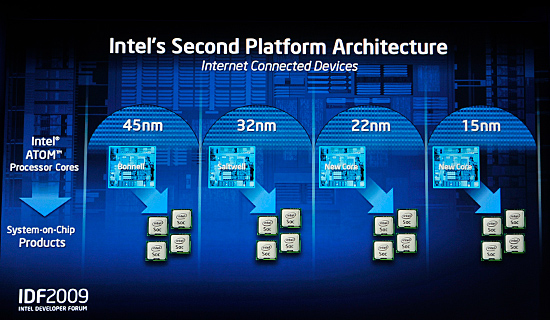
We'll get a brand new microarchitecture every "2 or so" years and transitions to smaller manufacturing processes on a regular basis.
Bonnell is the current 45nm core, Saltwell is the 32nm follow-up due out next year.
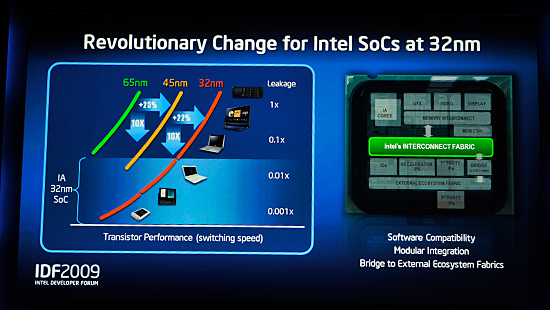
The move to smaller transistors ultimately has a different focus in the Atom space. While smaller manufacturing processes can be used to ramp clock speeds, in Atom the focus is going to be to reduce leakage current (and thus improve power efficiency/battery life). We'll see larger caches, more integration, but not necessarily higher clock speeds out of Atom in the future. Intel's goal here is to get Atom power consumption down to ARM levels.
Arrandale and Sandy Bridge Demos
An IDF keynote wouldn't be an IDF keynote without a demo of at least some unreleased CPU.
First up was Arrandale, the upcoming dual-core 32nm Westmere derivative. We got a demo of an Arrandale notebook running full disk encryption accelerated by the CPU's hardware AES instructions.
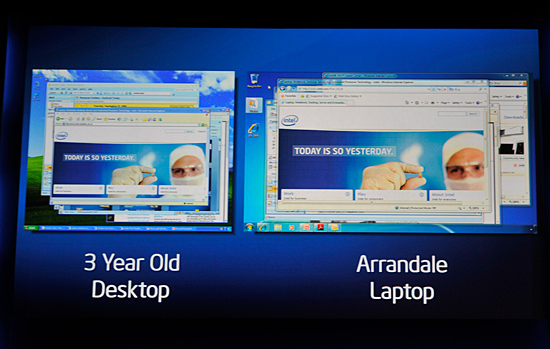
Sandy Bridge is the next major architecture shift due out in the second half of 2011. Built on 32nm, Sandy Bridge should be to Nehalem what Nehalem was to Conroe. It will also be the architecture that competes with AMD's long awaited Bulldozer cores. If all stays on track, 2011 should be very competitive in the high end CPU space.
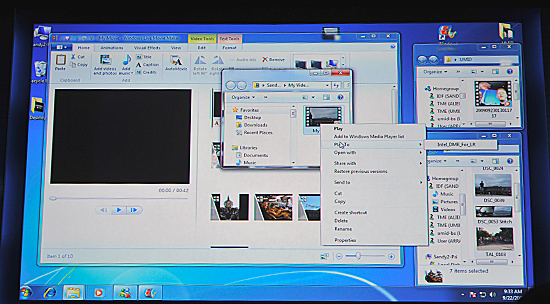
Sandy Bridge running Windows 7 and transcoding video already
The Intel Atom Developer Program
Intel announced the Atom Developer Program and its first three partners: ASUS, Acer and Dell.
The program is a way of encouraging development for Atom based platforms (and potentially testing the waters of moving people off of ARM and to x86 in the ultra mobile space).

ASUS CEO, Jonney Shih
ASUS' CEO Jonney Shih was present via pre-recorded video to pledge ASUS' support for the Atom Developer Program. Mr. Shih also announced ASUS' Eee App Store, for users to develop applications for Atom based Eee devices from ASUS.
Moblin 2.1 Demo
Moblin is a mobile optimized Linux distribution designed for notebooks, but next year we'll start seeing it on MIDs (again, one step away from getting Atom ready for the smartphone).
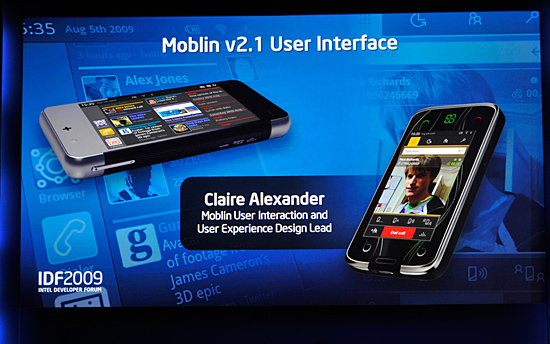
Intel did a quick demo of the Moblin 2.1 UI on a MID. The UI isn't particularly amazing by smartphone standards, but it's getting there. One more generation and I think we might have something that could really be used in a smartphone.
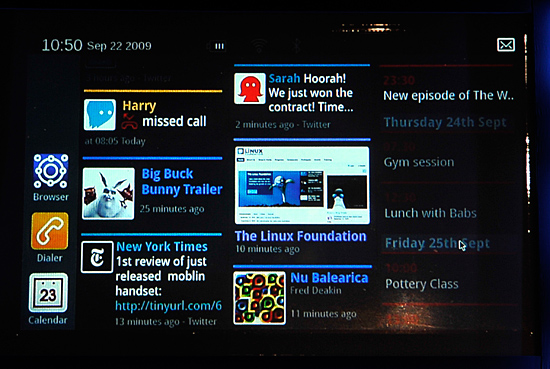
Intel's goal here is to bring the netbook usage experience to the MID. Honestly, that's been the biggest limitation to MID adoption in my mind: scaling down a desktop UI to a 5" screen just doesn't work well. A brand new touch UI is necessary for MIDs to be useful and Moblin delivers just that.
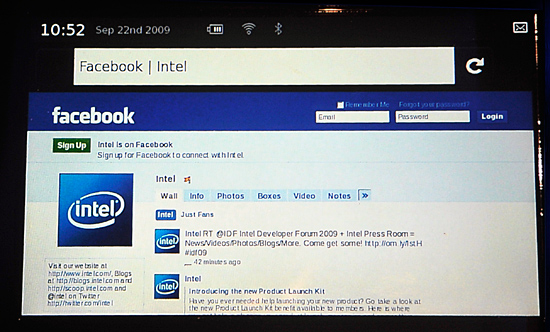
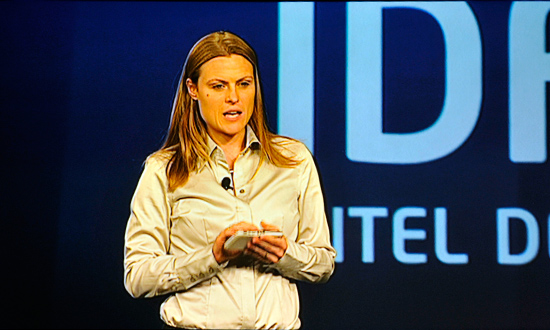
You can give Moblin a try on your netbook here.










34 Comments
View All Comments
Toka - Friday, September 25, 2009 - link
Im sorry, but 15nm!?2 questions, when, and more importantly how??
Id guess stacked patterning, far uv wavelengths, wet lith etc etc
quantum leakages / losses, what about them?
The mind boggles tbh.
yeeeeman - Thursday, January 14, 2021 - link
14nm actually. still in use :))jeffrey - Thursday, September 24, 2009 - link
Did Intel cover anything with the Itanium architecture?Tukwila?
Felofasofa - Wednesday, September 23, 2009 - link
Is there an upgrade path for Lynnfield? From what I gather there doesn't seem to be one, and only a 6 core for Bloomfield. What then, 1156/1366 are dead? Looking likely I reckon. Can't see Sandy Bridge dropping into any of todays boards. If this is correct Lynnfield is a sad joke and Westmere is not much better, just an intro into 32nm. Who's going to want Gulftown when SB is around the corner? Those wanting to get the last use of their X58 I guess.vshin - Thursday, September 24, 2009 - link
I don't think TA152H is your average user and all this flak he's causing is because his advice should not be aimed at the typical Anandtech audience. He's right that Bloomfield is better than Lynnfield but he isn't thinking from the point of view of say, a typical PC gamer that visits this site to figure out what to build for his next system. The gamer cares less about whether a cpu can fold proteins faster with 8 threads, and more about whether it can play current games fast, and keep up with upcoming games for DX11. And most importantly they want to pay as little as possible. These are the gamers that will never use SLI or some elaborate 24" multi-monitor setup. They are looking to spend $400-500 on CPU/mobo/ram and $250-300 for a video card.These folks should not be directed to buy a Bloomfield or have anything to do with the 1366 platform. It's fast but it's too expensive in terms of any real-world benefit in framerate. Yes it may have some longevity since Gulftown will use the same socket, but none of these guys will ever shell out $1000 for a CPU upgrade so it's a dead-end platform for them already.
Instead, TA152H is advocating that Clarkdale will be better than Lynnfield because of the IGP. It might be good for non-gaming, casual PC users, but the typical gamer is going to get a discrete video card anyways and will not really care for an IGP-CPU at all, especially if the on-board graphics will hamper overclocking. 32nm versions of Lynnfield aren't coming out till mid-2010. All that is left now is just Lynnfield i5/i7. Ideally the best option right now would be to get the i5 750, a cheap non-SLI mobo, then overclock it to 3.3-3.5 gHz. It doesn't have hyperthreading like the 860 but you won't see many games that will need 4+ cores/threads for the next couple years anyways.
The goal is to build an inexpensive system now to hold them over till late 2011 when Sandy Bridge is out and new motherboards will have SATA 6GB, USB 3.0, and PCIe 3.0. By then we should see more games that will effectively utilize 4+ cores as well. So why spend more for something that won't be measureably better for games, especially when you'll probably upgrade around the same time anyways? For this segment Lynnfield > Bloomfield in terms of performance/value.
TA152H - Wednesday, September 23, 2009 - link
That's always how it's been with computers. You can look at it as a negative, but, then, that would be kind of the wrong way.Look at it this way, if it were at the point that you were completely comfortable with buying something now, that wouldn't be obsolete, then that would tell a sad story about the future, wouldn't it?
Lynnfield is a sad joke, no argument there. But, what comes after it, based on the technology, should be good. It's going to be all a lot of people need, with low power use, and low cost. Most people don't upgrade processors, and just replace whole computers. Do you really change processors that often, without replacing motherboards? I do sometimes, but most often, by the time the processor is old, the motherboard should be replaced too.
If you really like socket longevity, AMD normally does a better job at that. Strangely, with just about everything platform related, they seem to do a great job now that they have ATI. Whoever said they made a mistake buying ATI was a fool. They make great chipsets, and great GPUs. They are the only thing keeping AMD relevant these days.
strikeback03 - Wednesday, September 23, 2009 - link
Well, the same argument could have been made for Penryn, who would want that when Nehalem was just around the corner. I wouldn't be too surprised if the sockets stay the same, but it will be up to the motherboard maker to provide a BIOS update, which few if any will.Felofasofa - Wednesday, September 23, 2009 - link
Sandy Bridge is a whole new architecture, and Intel's been totally silent about what sockets and chipsets will support it.vol7ron - Wednesday, September 23, 2009 - link
Intel, I'm rooting for you.I need something new to replace my iPhone 3G[S]. Apple's blocking of Jailbreaks and control over application development is upsetting me.
Please get into the smartphone soon, allow users to install a Linux, Google, or Windows distro. And as you do, please integrate a more powerful GPS, afterall, that's what makes these mobile devices amazing. W/o it, it'd just be another palm pilot/pda.
iwodo - Tuesday, September 22, 2009 - link
Even in Otellini's throne Pat has always been CEO in my mind. I dont know why got it mixed up. He has always been an Intel Spoke person. And has some sort of Steve Job Charisma. I honestly hope Pat will be back to Intel CEO someday. Andy Grove was the only Intel CEO that i really admire, and Pat being his sort of apprentice was another guy i admire as well.And Otellini has always given me the impression of Crag Barret.
In my mind, Intel will never be the same with out Pat.